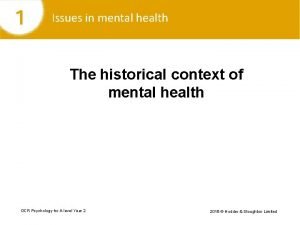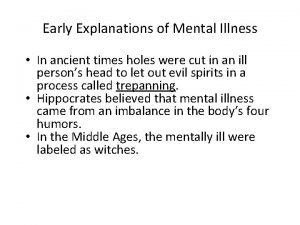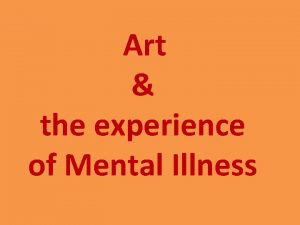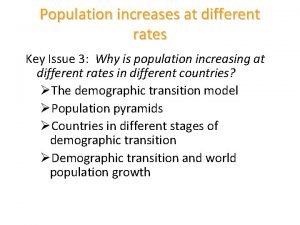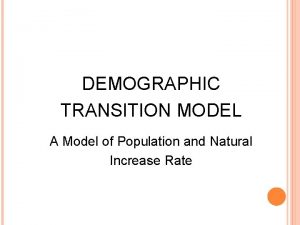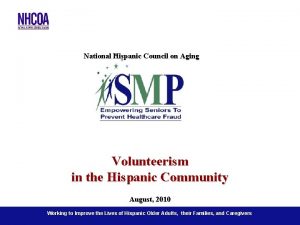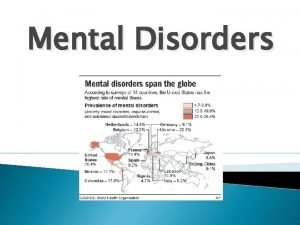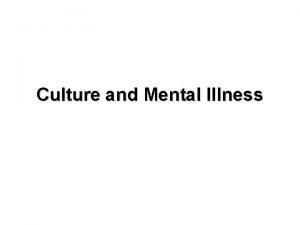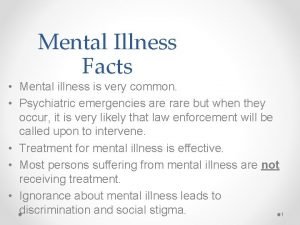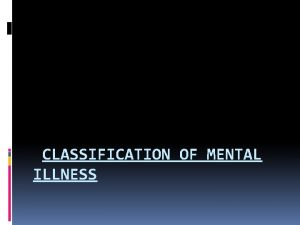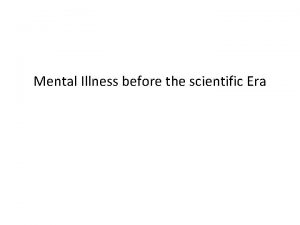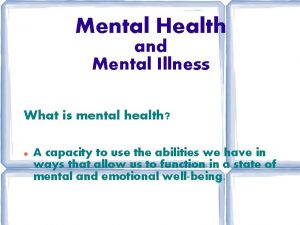Mental illness among the Hispanic and Latino population
























- Slides: 24

Mental illness among the Hispanic and Latino population * Rebecca Anchors, Jessica Copeland, Jessica De. Jonge, Brittany Pharo

*“Mental health is a state of successful performance of mental function, resulting in productive activities, fulfilling relationships with other people, and the ability to adapt to change and to cope with challenges. Mental health is essential to personal well-being, family and interpersonal relationships, and the ability to contribute to community or society” (Healthypeople. gov, 2013). *

*“Mental disorders are health conditions that are characterized by alterations in thinking, mood, and/or behavior that are associated with distress and/or impaired functioning. Mental disorders contribute to a host of problems that may include disability, pain, or death” (Healthypeople. gov, 2013). *“Mental illness is the term that refers collectively to all diagnosable mental disorders” (Healthypeople. gov, 2013). *

* “The term Hispanic refers to many cultures from the Spanish-speaking countries of Central and South America, as well as Mexico, the Caribbean, and Spain” (Interian & Diaz-Martinez, 2007) * Thirteen percent of the United States (U. S. ) population are Hispanic. (Interian & Diaz-Martinez, 2007) * Hispanics are rapidly becoming the largest minority population in the U. S. (Interian & Diaz-Martinez, 2007) *

* Familismo -heightened importance and centrality of family Respecto -exceptional respect for authority figures. * Personalismo -preference to interact with individuals rather than institutions * Marianismo -traditional female gender roles. (Interian & Diaz-Martinez, 2007) *

*Socio-demographic variables (such as unemployment) *Discrimination *Gender-based violence and childhood adversity *Emotional problems (such as divorce) *English proficiency *Immigration stressors: separation from family and cultural displacement *

* “Hispanics served in primary care less likely than non-Hispanic Whites to receive evidence-based depression care and are more likely to be served by physicians who fail to detect an existing mental health problem” (Cabassa, Lester, & Zayas, 2006). * “Latinos report receiving less mental health services and having poorer mental health status than other groups. Less than 5% of Latino immigrants with a mental health disorder receive needed care from mental health specialists and, for the few who do access mental health care, less than 30% return after their first visit” (Tran, Ornelas, Perez, Green, Lyn, & Corbie-Smith, 2012) * “Fewer than one in eleven Latinos with mental health disorders seek care from a mental health care specialist, and fewer than one in five seeks care from a general health care provider” (Lagomasimo, et al. , 2005). *

* Lack of health insurance * Unable to pay for health care * Immigration status * Lack of availability of bilingual providers or lack of culturally sensitive health services * Cultural values * Stigma regarding mental illness * Stigma regarding medications for mental illness * Demands at home (such as childcare) limit the woman’s ability to initiate or adhere to treatment *

Pender’s Health Promotion Model v. The health promotion model describes the multi dimensional nature of persons as they interact within their environment to pursue health. v. The model focuses on following three areas: v· Individual characteristics and experiences v· Behavior-specific cognitions and affect v· Behavioral outcomes *

Pender’s Health Promotion Model v. Health promoting behaviors should result in improved health, enhanced functional ability and better quality of life at all stages of development. v. Families, peers, and health care providers are important sources of interpersonal influence that can increase or decrease commitment to and engagement in health-promoting behavior. *

Leininger’s Culture Care Theory • Focus on providing care that is “meaningful and fits with cultural beliefs and life ways” (Leininger, 1999). • Care that combines medical and nursing knowledge with cultural values and beliefs to develop treatment plans that care for the client as a whole (Leininger, 1999). *

Peplau’s Nursing Theory v“The nurse and patient work together so both become mature and knowledgeable in the process, ” v. According to Peplau, the nurse fills many roles, the main focus of the nurse is to foster a trusting relationship with the patient, gaining the most knowledge possible about their lives in order to advocate and bring about the best possible outcome *

Peplau’s Nursing Theory Roles of the nurse in mental health of the Hispanic and Latino Population v Counselors : helps to understand integrate the meaning of current life circumstances , provides guidance and encouragement to make changes v Surrogate: helps to clarify domains of dependence interdependence and independence and acts on clients behalf as an advocate. v Resource Person : one who provides a specific needed information that aids in the understanding of a problem or new situation *

* Depressed individuals who join social groups reduce their risk of relapse in four years by 24 percent (Cruwys et al, 2014). * Support groups that identify with the individual and contributes to their overall sense of self have been proven to benefit depressive symptoms (Cruwys et al, 2014). * “The greatest opportunity for prevention is among young people” (Healthypeople. gov, 2013) * “Implementation is complex, and it is important that interventions be relevant to the target audiences” (Healthypeople. gov, 2013) *

* Culturally specific flyers posted in clinics/mental health offices * Meet bi-monthly * Spanish speaking staff/translation services available * Provide day care/transportation * Invite family and friends if client desires their presence. (Anxiety and Depression Association of America, 2014) *

* Meetings led by facilitator * Start meetings with discussions * Members set goals attainable by next meeting * Discuss successes of goal attainment * Discuss obstacles faced achieving goals * As a group discuss ways to achieve goals despite obstacles * Refreshments served upon conclusion of meeting to allow for members to socialize (Anxiety and Depression Association of America, 2014) *

*Meetings held in Community center *Comfortable setting *Spanish speaking facilitator and interpreter services available *Refreshments available to facilitate socializing before and after meetings (Anxiety and Depression Association of America, 2014) *

*Annual one-on-one meetings with support group attendees to determine if the group has benefited them. Evaluate personal goals set by individual and their accomplishments. *Attendees of group will fill out anonymous surveys annually; detailing changes in behavior and symptoms since attending group meetings. (Community Tool Box, 2013)

*Goal of Healthy People 2020: *“Improve mental health through prevention and by ensuring access to appropriate, quality mental health services”. *Why Is Mental Health Important? *“Mental disorders are among the most common causes of disability”. *“Mental health plays a major role in people’s ability to maintain good physical health”. *

*References * Ai, A. L. , Aisenberg, E. , & Weiss, S. I. (2014). Racial/ethnic identity and subjective physical and mental health of Latino Americans: an asset within? . American Journal of Community Psychology, 53, 173 -184. doi: 10. 1007/s 10464 -014 -9635 -5 * Anxiety and Depression Association of America. (2014). Start a support group. Retrieved from http: //www. ada. org/finding-help/getting-support/support-groups/start-support-group * Cabassa, L. J. , Lester, R. , & Zayas, L. H. (2006). “It’s like being in a labyrinth: ” Hispanic immigrants’ perceptions of depression and attitudes toward treatments. Journal of Immigrant Health, 9, 1 -16. doi: 10. 1007/s 10903 -006 -9010 -1 * Caplan, S. , & Whittemore, R. (2013). Barriers to treatment engagement for depression among Latinas. Issues in Mental Health Nursing, 34, 412 -424. doi: 10. 3109/01612840. 2012. 762958

* Community Tool Box. (2013). Developing an evaluation plan. Retrieved from http: //ctb. ku. edu/en/table-of-contents/evaluate/evaluation -plan/main * Cruwys, T. , Haslam, S. A. , Dingle, G. , Jetten, J. , Hornsey, M. , Chong, E. M. & Oei, T. (2014). Feeling connected again: Interventions that increase social identification reduce depression symptoms in community and clinical settings. Journal of Affective Disorders, 159(20), p 139146. doi: 10. 1016/j. jad. 2014. 02. 019 * Current nursing open access nursing research and review articles. (2012, January 31). Health promotion model. In Nursing theories a companion to nursing theories and models. Retrieved April 28, 2014, from http: //nursingplanet. com/health_promotion_model. html * Current nursing open access nursing research and review articles. (2013, September 9). Peplau's theory of interpersonal relations. In Nursing theories a companion to nursing theories and models. Retrieved April 28, 2014, from http: //nursingplanet. com/health_promotion_model. html

* Hansen, M. C. , Cabassa, L. J. (2012). Pathways to depression care: help-seeking experiences of low-income Latinos with diabetes and depression. Journal of Immigrant Minority Health, 14, 1097 -1106. doi: 10. 1007/s 10903 -012 -9590 -x * Healthypeople. gov. (2013, November 13). Mental health and mental disorders. In 2020 topics and objectives. Retrieved April 8, 2014, from http: //www. healthypeople. gov/2020/topicsobjectives 2020/overview. aspx? topicid=28 * Lagomasimo, I. , Dwight-Johnson, M. , Miranda, J. , Zhang, L. , Liao, D. , Duan, N. & Wells, K. (2005). Disparities in depression treatment for latinos and site of care. Psychiatric Services, 56(12), 1517 -1523. Retrieved from http: //search. proquest. com/docview/213061695? accountid=10825 * Leininger, M. (1999). What is transcultural nursing and culturally competent care. Journal of Transcultural Nursing, 10(1), p 9 -12. doi: 10. 1177/104365969901000105

* Liefland, L. , Roberts, D. L. , Ford, R. , Stevens, B. J. (2013). Depressive symptoms among helpseeking Latinas in a disadvantaged, urban, northeastern community mental health center. Community Mental Health Journal, 50, 331 -335. doi: 10. 1007/s 10597 -013 -9655 -x * Pincay, I. E. , & Guarnaccia, P. J. (2006). “It’s like going through an earthquake”: anthropological perspectives on depression among Latino immigrants. Journal of Immigrant Minority Health, 9, 17 -28. doi: 10. 1007/s 10903 -006 -9011 -0 * Sorkin, D. H. , Pham, E. and Ngo-Metzger, Q. (2009), Racial and Ethnic Differences in the Mental Health Needs and Access to Care of Older Adults in California. Journal of the American Geriatrics Society, 57: 2311– 2317. doi: 10. 1111/j. 1532 -5415. 2009. 02573. x

* Tran, A. N. , Ornelas, I. J. , Perez, G. , Green, M. , Lyn, M& Corbie-Smith, G. (2012). Evaluation of Amigas Latinas Motivando el Alma (ALMA): a pilot promotora intervention focused on stress and coping among immigrant Latinas. Journal of Immigrant Minority Health, 16, 280 -289. doi: 10. 1007/s 10903 -012 -9735 -y * Vega, W. A. , Karno, M. , Alegria, M. , Alvidrez, J. , Bernal, G. , Escamilla, M. , . . . Lopez, S. (2007). Research issues for improving treatment of U. S. hispanics with persistent mental disorders. Psychiatric Services, 58(3), 385 -94. Retrieved from http: //search. proquest. com/docview/213085072? accountid=10825
 Chapter 20 mental health and mental illness
Chapter 20 mental health and mental illness Mental health jeopardy questions
Mental health jeopardy questions Historical views of mental illness psychology ocr
Historical views of mental illness psychology ocr Fair housing act mental illness
Fair housing act mental illness Mental illness in ancient times
Mental illness in ancient times Axis 1 and axis 2 disorders
Axis 1 and axis 2 disorders Mark rothko mental illness
Mark rothko mental illness Catherine earnshaw mental illness
Catherine earnshaw mental illness Americanization of mental illness
Americanization of mental illness Classification of mental illness
Classification of mental illness Ksi depression
Ksi depression Nathalia ramos speaking spanish
Nathalia ramos speaking spanish Key issue 3 why does population growth vary among regions
Key issue 3 why does population growth vary among regions Why does population growth vary among regions
Why does population growth vary among regions Hispanic cultural views on teenage pregnancy
Hispanic cultural views on teenage pregnancy National hispanic council on aging
National hispanic council on aging Hispanic american scientists
Hispanic american scientists Is hispanic an ethnicity
Is hispanic an ethnicity Is hispanic an ethnicity
Is hispanic an ethnicity Domestic violence in the hispanic community
Domestic violence in the hispanic community Most famous hispanic artists
Most famous hispanic artists Hispanic dude
Hispanic dude Chapter 4 section 1 population dynamics answer key
Chapter 4 section 1 population dynamics answer key Population ecology section 1 population dynamics answer key
Population ecology section 1 population dynamics answer key Population ecology section 1 population dynamics
Population ecology section 1 population dynamics


